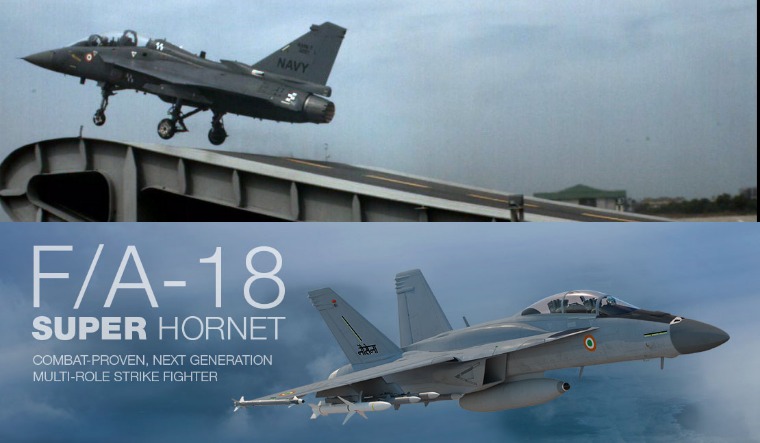American aerospace giant Boeing is regarded as one of the frontrunners for a contract to supply the Indian Navy 57 fighters jets for operations off aircraft carriers.
Boeing responded to an Indian Navy request for information by offering its F/A-18 E/F Super Hornet fighter for the contract in 2017. The contract was then estimated to be worth at least $6.6 billion.
Boeing is offering the Indian Navy the latest version of the Super Hornet, called the Super Hornet Block 3. The Super Hornet Block 3 features advances in electronics, display systems and increased fuel capacity. The Super Hornet Block 3 is also on offer to the Indian Air Force.
On Tuesday, Boeing confirmed that it was conducting tests for launching the Super Hornet off 'ski-jumps' at a US Navy base at Patuxent River in Maryland.
The US Navy uses catapults to launch aircraft, such as the Super Hornet, from its aircraft carriers. A catapult imparts additional momentum to the aircraft, enabling it to take off with maximum weight from a carrier, which has less runway length than an airfield.
But catapult have high-power generation requirements that are typically not available on non-nuclear-powered aircraft carriers, such as those the Indian Navy will use for foreseeable future.
The Indian Navy's existing aircraft carrier, the INS Vikramaditya, and the under-construction Vikrant, have ski-jumps. A ski-jump is a curved ramp at the end of a runway that force an aircraft upwards without it reaching maximum speed. The website of the US F-35 stealth fighter explains a ski-jump as simultaneously launching "aircraft upward and forward, enabling take-offs with more weight and less end-speed than required for an unassisted horizontal launch".
While ski-jumps allow an aircraft to take off with increased weight and give a greater safety margin, the total take-off weight of the aircraft would still be lower than that provided by using catapult-assisted launch.
Boeing released the statement on the ski-jump tests for the Super Hornet to US defence website The Drive.
"Boeing and the U.S. Navy are in the beginning phases of operating an F/A-18 Super Hornet from a ski jump at Naval Air Station Patuxent River to demonstrate it is STOBAR (short take-off but arrested recovery) compliant for the Indian Navy. Boeing completed extensive analysis and more than 150 flight simulations on F/A-18 compatibility with Indian aircraft carriers, and while our assessment has shown the Block III Super Hornet is very capable of launching off a ski jump, this is the next step in demonstrating that capability. More details will be released upon the conclusion of the test demonstration," Justin Gibson, a Boeing spokesperson, told The Drive.
An Indian journalist, Saurabh Joshi, had earlier tweeted about the ski-jump tests.
Boeing had indicated in February that it would commence ski-jump tests for the Super Hornet this year. In fact, Boeing has touted ski-jump compatibility for the Super Hornet to attract the Indian Navy as far back as 2008. In 2008, a Boeing official told Hindustan Times about simulations of ski-jump launches.
"“In our simulation, we discovered that not only could the Super Hornet take-off from a ski-jump, but could do so with a significant weapons load," the official told Hindustan Times.
Boeing's confirmation of ski-jump tests is significant as it is considered one of two frontrunners for the Indian Navy contract, the other being the naval version of the Dassault Rafale. In 2018, Economic Times reported Dassault had provided data of simulation of ski-jump launches of the Rafale to the Indian Navy. "… extensive tests and software analysis have been conducted by the French side on the Rafale to show that it can operate with a meaningful load from ski-jump carriers," Economic Times reported.


